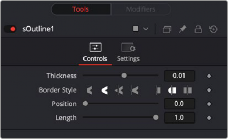
< Previous | Contents | Next >
For instance, if a NGon alpha channel is set to .5, enabling the Allow Combining checkbox maintains that value even if the shape passes through a duplicate or grid node that causes the shape to overlap. Disabling the checkbox causes the alpha channel values to be compounded at each overlapping area.

Allow Combining Enabled (left), Allow Combining Disabled (right)
The Settings tab in the Inspector is common to all Shape nodes. These common controls are described in detail at the end of this chapter in “The Common Controls” section.
sOutline

![]()
The sOutline node
The sOutline node is used to create outlines from merged or boolean compound shapes. The individual shapes retain their own style, color, size, position, and other characteristics. The only difference is the border thickness, border style, position, and length are applied to all incoming shapes uniformly in the sOutline node.
Like almost all shape nodes, you can only view the sOutline node’s results through a sRender node.
External Inputs
The following input appears on the node’s tile in the Node Editor:
— Input1: [orange, required] This input accepts the another shape node’s output, but more likely a compound shape from a sMerge or sBoolean. An outline is created from the compound shape connected to this input.
Basic Node Setup
The sOutline node takes a single input that is most often from a compound shape, however, it can sometimes be useful on single shapes to create double outlines. The output of the sOutline can then be output to another Shape node or to a sRender node for viewing or compositing into the greater node tree.

A compound shape from an sBoolean node is connected to an sOutline for creating a complex outlined shape
Inspector

![]()
The sOutline Controls tab
Controls
The Controls tab is used to define the outline thickness, border and cap style, position, and length that is applied to the compound shape connected to the input.
This parameter controls the width of the outline.
The Border Style parameter controls how the outline joins at the corners. There are three styles provided as options. Bevel squares off the corners. Round creates rounded corners. Miter maintains pointed corners.
Three Cap Style options are used to create lines with flat, rounded, or squared ends. Flat caps have flat, squared ends, while rounded caps have semi-circular ends. Squared caps have projecting ends that extend half the line width beyond the end of the line.
The caps are not visible unless the length is below 1.0.